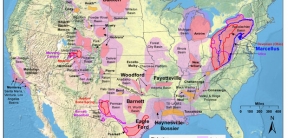Caitlin Johnson, 2011-2013 Fellow at the George Gund Foundation authored this post.
Two years ago, I would have thought “fracking” was some sort of new curse word, or that maybe it had something to do with the Fraggles (yes, I am a child of the ‘80s). I never would have fathomed that my fellowship with the George Gund Foundation would lead to a new passion and professional focus. When people ask me what I do, I try to explain that I work for a foundation where we give money away to important causes - like how to help make fracking safer and more transparent. First, people usually want to know if I can give them money (I cannot). Then they ask why I am so concerned and passionate about fracking and why exactly does it matter to the Gund Foundation. Here is how I respond.
The George Gund Foundation is a place-based funder that focuses mostly on Greater Cleveland and Northeast Ohio. We have five program areas: education, the arts, economic and community development, the environment and health and human services. A considerable portion of our funding supports state policy work, especially regarding the environment and health and human services. Our economic development grant making is based in the 16 county region of Northeast Ohio, containing Cleveland, Youngstown, Akron and Canton. Because of its transformative effect on communities and its potential to impact the natural environment and human health, we see fracking as an issue that cuts across the latter three program areas.
In many ways, the natural gas boom seems like déjà vu all over again. Ohio funders can merely look to our neighbor West Virginia to see that an economy based around an extractive resource – coal mining in that state’s case – is not a pretty thing once the boom is over. In Ohio, too, we have pockets of rural poverty in former coal mining communities. It seems to me that natural resource extraction is more of a curse than a blessing in the long run. Many economists agree.
Most economic development experts eschew the practice of “smokestack chasing,” or pursuing big industries through tax breaks in favor of investments in human capital and innovation. Despite this, Ohio has some of the nation’s lowest oil and gas severance tax rates. The industry says Ohio cannot raise taxes or else they will drill elsewhere. Although the governor proposes an increase in the severance tax rate, he plans to return that revenue to all Ohioans through an income tax cut.
As the largest funder of the Fund for our Economic Future, a collaboration of funders throughout Northeast Ohio, the Gund Foundation is deeply committed to responding to our region’s deindustrialization and the economic havoc it wrought. The Fund invests in organizations that assist innovative startups, strengthens the region’s cluster of technologies, and promote our robust manufacturing sector. While the foundation understands fracking may create jobs, we also worry that a lack of planning and adequate taxation could produce a boom-bust cycle, and ultimately leave Northeast Ohio in a weaker position economically.
Secondly, the foundation worries that Ohioans do not have a say in this matter. A 2004 law stripped municipalities of local control over oil and gas drilling. Ohio also allows “mandatory pooling,” which allows drilling companies to go through a landowner’s property to drill if a landowner refuses to sign a gas lease, but most of his neighbors have. There are also provisions in Ohio law, which prohibits citizens from appealing the issuance of a drilling permit. Meanwhile, a gas company denied a permit is able to appeal. Moreover, under Ohio law, gas companies are not required to disclose all the chemicals used in fracking fluid—the mixture of water, sand and chemicals injected deep underground to open natural gas deposits—despite the disastrous potential for contamination when the fluid is being transported.
In order to promote transparency and engagement, the Gund Foundation has made grants to FracTracker to expand public access to fracking-related data and maps in Ohio, as well as to the Ohio Organizing Collaborative, which empowers the myriad of citizens groups that have responded to the issue. We have also enlisted environmental public interest law firms Earthjustice and Natural Resource Defense Council to survey Ohio’s existing regulatory structure and determine what, if any, legal avenues might be pursued.
Many people in Ohio want to see fracking stopped completely. Many others say the economic possibilities are too good to miss. We at the Gund Foundation believe a balance can be struck through sensible regulations and improved disclosure. Despite its many downsides, fracking presents a great opportunity for environmental funders. Citizens of all stripes are concerned about the issue. Some worry about private property rights protection, or about the lack of local control. Others fear contamination of local water supplies or that jobs will not go to Ohioans.
Fracking touches everything – and everyone. If funders want to build a robust coalition around environmental issues, fracking can show us the way. This is an opportunity to change how we frame environmentalism as a movement for health equity, democracy and social and economic justice versus just hippy tree huggers out there fighting for polar bears. As I prepare to leave my fellowship at Gund and enter the world of advocacy and organizing, I hope all of us are able to seize the moment.
Caitlin Johnson is the 2011-2013 Fellow at the George Gund Foundation in Ohio. There she has worked across program areas and with HEFN members on the issue of fracking. She will end her fellowship and enter world of advocacy and organizing in summer 2013.


